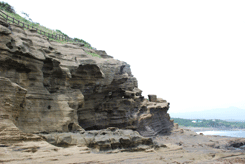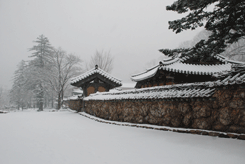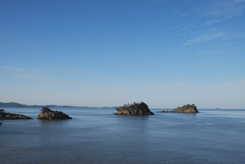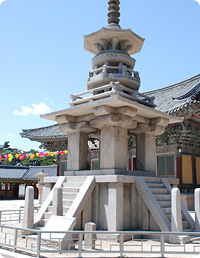UNESCO Heritages
 |
 |
 |
Gwangneung Arboretum / Gochang / Jejudo / Seoraksan / Sinan Dadohae
Gwangneung Arboretum
About 30km northeast of Seoul is Gwangneung, the home of the National Arboretum. It has been carefully managed for more than 500 years. It was designated as the Imperial Forest of the Joseon dynasty. This dense forest is a part of the tomb site of King Sejo, the 7th ruler of the Joseon dynasty. This area has one of the most diverse ecosystems in Korea. Gwangneung Forest, the biggest repository of diverse plant species in Korea, has been officially listed as a biosphere reserve by UNESCO. The biosphere zone is a core area that houses broadleaf trees that have grown to their fullest, along with other endangered species and is where strict conservation policies are in place. The buffer zone that surrounds and protects the core area is facilitated as a place to study and learn the ecosystem. The arboretum supports more than 1,900 native and 12,800 non-native plants of 2,844 different species of trees, shrubs, and herbs. It is also the habitat of rare redheaded woodpeckers, as well as giant flying squirrel, long-horned beetle. The arboretum consists of 15 special sections; wetland flora, alpine plants, aquatic plants, deciduous trees conifer trees, ground cover plants, medicinal and edible herbs, subtropical plants, foreign flora, and botanical plants. About 5 million square meters arboretum with its lovely trails under the woods are of a great spot for refreshment. The Arboretum Museum displaying 28,000 articles is another attraction of the area. It displays various fauna and flora samples, arboriculture technology, natural resources and diverse products made from wood. Opened on October 15, 1999, the ecological trail of 462m winds through the pristine forest. Walking along the wooden plank paths, visitors can closely observe the community of living organisms interacting with their environment, which is the essence of nature. Visitors can set their eyes on tender spring greens, or crimson foliage, or spectacular snowcaps. Internet reservation is required to visit the arboretum. Closed on Sunday and Monday.
Gochang
Gochang is a small town dominated with UNESCO world heritage Dolmen, Seonunsa temple and Gochang fortress. Much was lost during Japanese invasion in 1597, but Seonunsa temple remains its reputation. The temple is also famous for its camellias, which grow on the low hill behind the main worship hall. Constructed in 1453, Gochang Fortress has a total perimeter of 1.7km. Legend has it that 6th, 16th and 26th of the month are regarded as the best time to walk around the wall. It has such tactical features as three half-moon-shaped protrusions, six parapet structure and moats. There were 22 buildings including a commander's headquarters, a guest house, two ponds and four fountains inside the fortress. But most of them were burnt down during the Hideyoshi invasion. The existing remains are having restored as a visage of old days from 1976. But, today the festival is held regular basis on and around the ninth day of the ninth lunar month. In Dapseong Nori, local women walk around the fortress carrying a stone on their heads, with the belief being that the one trip around the fortress will cure leg disease, two trips will prevent disease and give you a long life, and three trips will bring you to the paradise.
Gochang tidal flat of 40.6 square kilometer is the largest among the Ramsar wetlands in Korea. The tidal flat is famous for its diverse array of natural monuments and endangered wildlife including the Kentish Plover, Eurasian Oystercatcher, red-backed sandpiper, and whooper swan. UNESCO has recognized the environmental and community values of Gochang's mud flats and wetlands, as well as its Seonun mountain park, dolmen structures and wild animal reservation zone and designated as a protected biosphere reserve, thus became the fifth in the South Korean list.
The Gochang, Hwasun and Ganghwa Dolmen Sites are the location of hundreds of stone dolmen which were used as grave markers and for ritual purposes during the first millennium BCE when the Megalithic Culture was prominent on the Korean Peninsula. The Korean name for dolmen, Goindol, comes from the southern-style dolmen. It literally means a stone that is propped up by other stones. This is a primary method of discriminating dolmen from other rocks. The sites were designated as a World Heritage Site by UNESCO in 2000. Korea is said to contain more than 40% of the world's dolmen which are mostly concentrated in these three sites. In the whole Korean Peninsula, some 36,000 dolmens have been recorded by academics. In Gochang, the area with the largest dolmen concentration in the Korean Peninsula, 1,686 dolmens have been found in 205 groups. The dolmens were built from east to west at the foot of a series of hills at an altitude of 15 to 50 meters. Generally, the capstones of the dolmens are around 1 to 5.8 meters in length and may weigh up to 225 tons. In particular, the 447 dolmens were designated as World Cultural Heritage Sites. This density of dolmen distribution is unparalleled in the world.
Jejudo
The Jeju Island, 73km long and 41km wide, came into existence when lava spewed from a submarine volcano and surfaced from the sea. Jejudo, the largest and most famous of 3,300 islands of Korea, is approximately within an hour flight from Seoul or Busan. Popularly known as the island of three many or plenties or sometimes referred to as "Samdado Island" because of its abundance of rocks, wind, and women. Past volcanic activity has littered the island with an assortment of beautiful and unusually-shaped black rocks and wind from the ocean blows steadily throughout the year. The island is also known for three lacks (beggars, thieves and locks), which is a beautiful part of culture, and three treasures (flora, marine ecology and folklore). The island's landscape formed by the volcanic eruption and its plant life are radically different from the mainland. Several scenic waterfalls, lava cliffs along the coastal water, huge lava caves, and hundreds of volcanic cones are scattered around the island. The island still offers a good opportunity to witness the women divers at work in the sea. The Jeju Island is inextricably linked to its stone culture. It starts and ends with stone. Jeju people are born in stone houses surrounded by stone fences. They work in fields fenced in by stacked stones. When they die their bodies are returned to the rocky earth, buried under a mound surrounded by stone. Historically, the island was used as a place of exile for those who fell out of favor in the Korean court. Jeju's phenomenal natural beauty, historical legacies, quirky museums, and array of water sports make it one of the best vacation spots in Korea.
Seoraksan
Designated as National Park in March 1970, it has an area of 398 square kilometer. Located along the eastern coast of Sokcho city, offers the visitors unsurpassed mountain beauty. It is the third highest peak in southern Korea, next to Hallasan and Jirisan. The Park is dominated by the chains of mountains with their scenic valleys, crystal clear streams and lush green forests offering outdoor enthusiasts with hiking, trekking, climbing, white water rafting, ski and golf, etc. The park is the home of 25 species of mammals, 90 species of birds, 11 kinds of reptiles, 360 insects and 939 species of plants. The rugged peaks, fantastic cliffs, numerous waterfalls, unique rock formations, and scenic valleys altogether make this park and surrounding area some of the best scenery on the Korean peninsula, and give this area an unparalleled popularity around the year. The spring brings full of blooms and the summer creates lush green slopes and crystal clear streams tumbling over the cataracts. Fall changes foliage into brilliant colors and even in the winter, the snow blankets the hushed landscape, bringing serenity and a quiet beauty. Only half an hour from the park there are white sand beaches along the gentle coasts. As cooler temperature come to the Korean peninsula and autumn foliage begins to turn to crimson red and golden yellow, the scenic spires guarding the valleys of Seoraksan Mountain beckon to tourists.
Sinan Dadohae
Sinan Dadohae, an archipelago of more than 420 islands, has been designated as a Biosphere Reserve by UNESCO. The area has a very unique ecosystems covering biological spectrum spatially networking with terrestrial, tidal flat and marine landscapes. Core zone of the Biosphere Reserve shows dynamic mosaic landscapes to which various biological species are spatially adapted in the habitats. The southern sea has mild weather and creates exotic atmosphere. It has many beautiful islands with a wide range of flora and fauna As well as geographical isolation of biological species, this area shows the climatic characteristics in warm and humid ocean. Of the popular islands among visitors includes Heuksando, Hongdo, Bigeumdo and Dochodo, including the expansive mudflats and Salt Field on Jeungdo. The traditional form of salt production is still practiced, and the first case that salt fields have been designated a Biosphere Reserve. Also, it is home to a great diversity of vegetation including silver magnolias, camellias and many other plants, which grow in the saline conditions of this temperate zone. Out of a total 452 species of birds in Korea, more than 337 species of migratory birds winter here. Heuksando and Hongdo are among the popular islands for their peculiar rock formations and cliffs. Heuksando Island, comprising of 11 uninhabited and 89 inhabited islands, is located at the southern end of Korea about 93 km away from Mokpo. The island got its name from the vivid colors of its mountain and surrounding seas that give it a black appearance which couldn't be further from the truth. Its coastline is abundant with small port villages that also contain some pleasant beaches. About 20km further to the west is located Hongdo embracing about 20 islands. Its small population consists of two villages that commute to each other via boat. The island is adorned with spectacular sea cliffs that fall into deep clear jade colored water that house local food specialties such as Skate, Sea Bream, Sea Bass, Abalone, and Seaweed. When the sun sets over the island, the whole area takes on a reddish hue. The seashore is bordered by towering sea cliffs with diverse shapes of rocks.






